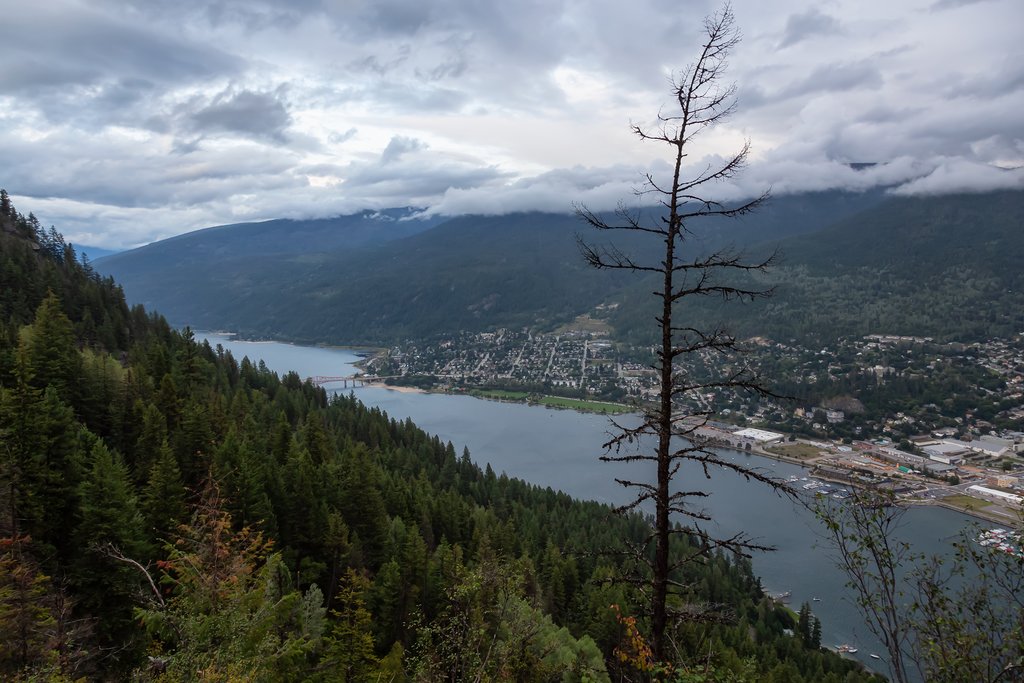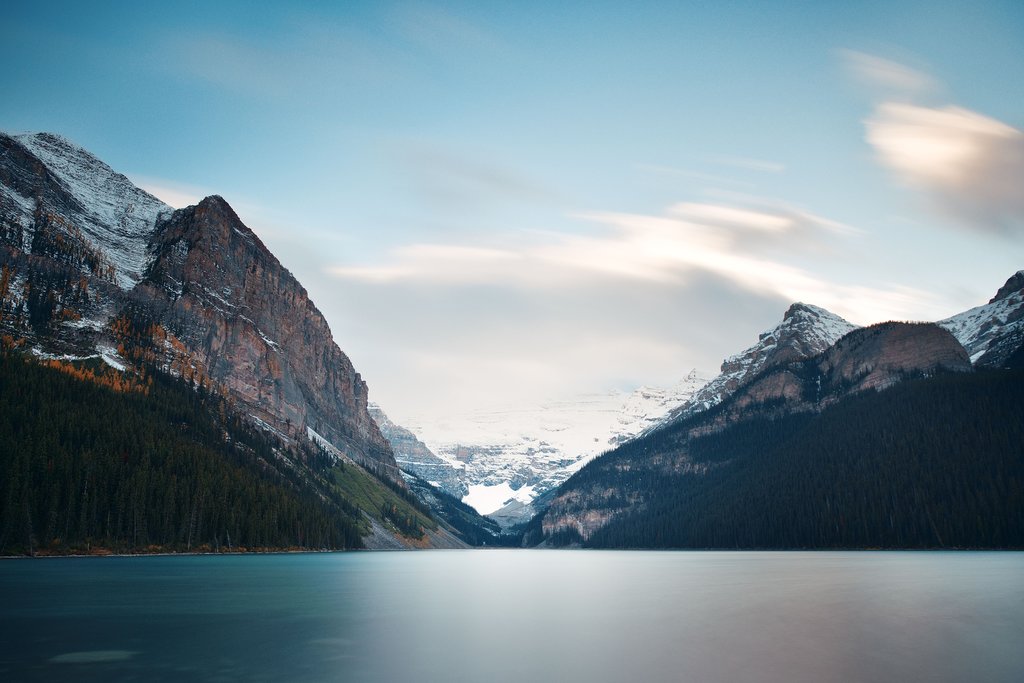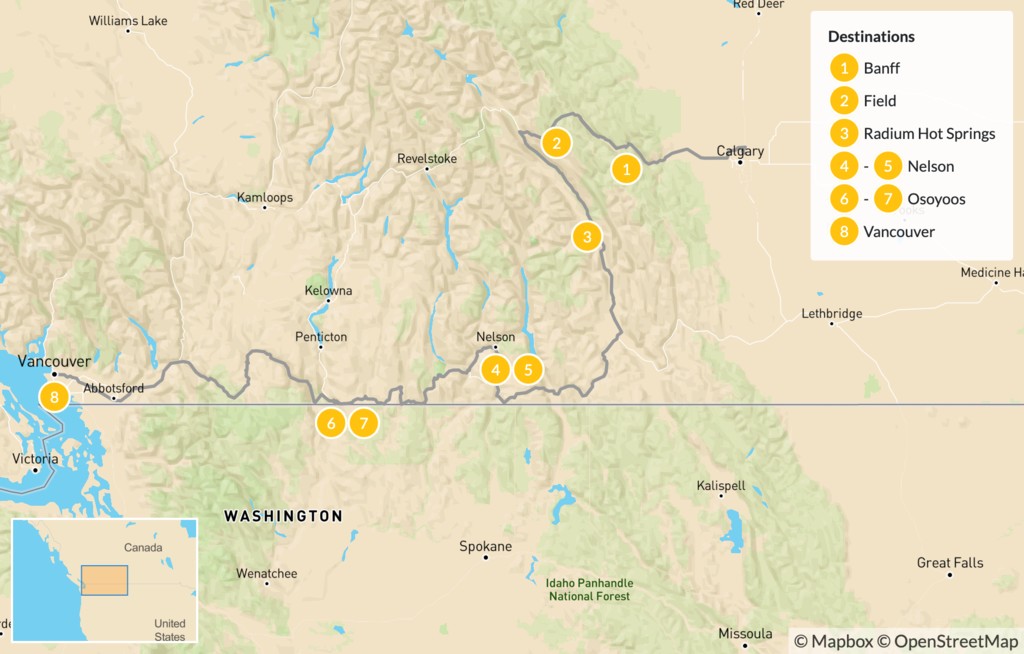Highlights
- Trek the Plain of Six Glaciers Trail ending with tea in Lake Louise
- Admire the historic architecture of artsy Nelson and relax by the waterfront
- Discover Okanagan wine country and sip wines from the Black Sage Bench
- Wander the cobbled streets of Vancouver’s historic Gastown
Brief Itinerary
| Day | Highlights | Overnight |
|---|---|---|
| Day 1 | Arrive in Calgary, Drive to Banff (2 hours) | Banff |
| Day 2 | Banff to Yoho National Park (1 h 30 min) | Field |
| Day 3 | Yoho National Park to Radium Hot Springs (2 hours) | Radium Hot Springs |
| Day 4 | Radium Hot Springs to Nelson (4 hours) | Nelson |
| Day 5 | Explore around Nelson | Nelson |
| Day 6 | Nelson to Osoyoos (3 hours) | Osoyoos |
| Day 7 | Explore around Osoyoos | Osoyoos |
| Day 8 | Osoyoos to Vancouver (4 h 30 min) | Vancouver |
| Day 9 | Depart Vancouver |
Detailed Itinerary
Day 1: Arrive in Calgary, Drive to Banff (2 hours)

Welcome to Calgary, the gateway to the Canadian Rockies! Instead of staying in Calgary, grab any supplies you need and follow the Trans Canada Highway (Highway 1) west toward Banff, a popular base camp for exploring Banff National Park. En route, stop in Canmore for a quick meal and a short stroll. Check out the eclectic PD3 by Blake restaurant where they serve Asian-inspired cuisine from a remodeled 1962 silver double-decker bus.
Banff, a small mountain town located within Banff National Park (Canada's first national park), is one of Canada's most visited destinations and can become quite busy during summer months. You'll find year-round opportunities for outdoor adventures and can access most of the park's iconic sites on a day trip.
Check out the Banff Park Museum for an introduction to the park and its local wildlife. There's also the Banff Gondola which takes you to the top of Sulphur Mountain for a walk along the boardwalk trail (or skip the gondola and hike up for free). From the summit, you'll have great views of the nearby mountains and can also grab dinner at Sky Bistro. Take an evening dip in the hot mineral waters of the Upper Hot Springs Pool (closes 10 pm) before signing off for the night.
Driving time (Calgary International Airport to Banff): 2 hours (79 miles / 127 km)
Day 2: Banff to Yoho National Park (1 h 30 min)

Fuel up on breakfast at Wild Flour Bakery and proceed to follow the Bow Valley Parkway, a scenic alternative to Highway 1, west out of Banff. Take advantage of the short drive to Field with several notable pitstops, the first to trek along the cantilevered walkways of Johnston Canyon. Considered one of the busiest hikes of the park, come early to beat the mob.
Choose between the 1.5-mile (2.4-km) Lower Falls trail and the slightly steeper Upper Falls route. Allow two to two and a half hours to complete both, yet if there's interest, plan for a picnic at the Ink Pots, five pristine aquamarine-colored pools beyond Upper Falls. It's another 1.7 miles (2.7 km) one way, but worth the effort. Next, snap photos of Storm Mountain from a convenient viewpoint west of Castle Junction and take pause at the memorial plaque farther along the parkway to read about Canada's World War I Castle Mountain Internment Camp.
Close to Alberta's border with British Columbia sits captivating Lake Louise. Admire the turquoise lake and backdrop of chiseled mountain peaks and Victoria Glacier before taking to the trails. If time allows, hike the Plain of Six Glaciers Trail (around four hours), an intermediate-level 6.6-mile (10.6-km) route with an elevation gain of 1,198 feet (365 m). Conveniently, the trail leads to the less-visited Plain of Six Glaciers Teahouse (closes at 5 pm), where you can down thick-cut sandwiches and cups of tea.
Devote time to discover the equally beautiful—if not more rugged—nearby glacier-fed Moraine Lake. Hike the accessible Lakeshore Trail along the deep-teal lake (1 mile / 1.6 km) or the 3.6-mile (5.8-km) Consolation Lakes Trail. (Best to come closer to 5 pm when the crowds have thinned.)
It's only a 30-minute drive to your accommodation in Field, the only town within Yoho National Park, so stay in Lake Louise as long as you like taking Highway 1 into British Columbia when you're ready.
Driving time (Banff to Field): 1 hour, 30 minutes (52 miles / 84 km)
Day 3: Yoho National Park to Radium Hot Springs (2 hours)

Spend the better part of the morning discovering Yoho's most accessible highlights, getting an early start to avoid the throngs of travelers. If you're feeling ambitious, drive the series of switchbacks (about 30 minutes each way) to reach Takakkaw Falls, the most impressive in the Canadian Rockies (opens mid-June) before stopping at Natural Bridge on your way to visit Emerald Lake. Allow 90 minutes to walk the three-mile (5.2-km) Emerald Lake Loop, taking in the jewel-hued lake encircled by spruce and firs and the snow-capped Rockies.
From here, follow Highway 1 on your way out of the park toward Golden, famous for white-water rafting and kayaking on the Kicking Horse River, and stop for lunch with a view. Step aboard the Golden Eagle Express Gondola up Kicking Horse Mountain to eat at the Eagle's Eye Restaurant and then pick up Highway 95 south to Radium Hot Springs, just over an hour's drive away in the rugged mountain wilderness.
Located at the southern boundary of Kootenay National Park, the town of Radium Hot Springs is home to wandering bighorn sheep and, of course, its namesake hot springs—one of the largest hot spring mineral pools in Canada. Drive the 10 miles (16 km) east of Radium for sweeping vistas of the Mitchell and Vermillion Mountains and the Kootenay River below and then on the way back, pull over to go on a short hike. Opt for the 3.7-mile (6-km) Juniper or Sinclair Canyon trail that leads you into the canyon with an elevation change of 850 feet (260 m).
Complete the day with a warming soak in the outdoor mineral-rich waters of Radium Hot Springs, followed by a casual meal accompanied by a glass or two of provincial wine.
Driving time (Field to Radium Hot Springs): 2 hours (99 miles / 160 km)
Chat with a local specialist who can help organize your trip.
Day 4: Radium Hot Springs to Nelson (4 hours)

Get an early start to the day with breakfast at Bighorn Café before heading south alongside the Columbia River, passing by lakes, hot springs, and quaint communities with the every-present Kootenay Rockies just beyond.
For a unique mid-morning break, veer off Highway 93 for 11 miles (18 km) to soak in the natural, rock-lined hot pools of Lussier Hot Springs in Whiteswan Lake Provincial Park accessed via a gravel logging road. Set amid a chilly river, you'll want sturdy water shoes to mitigate the slick rocks. Farther south, consider pulling over in the small community of Kimberley to stroll The Platzl, a Bavarian-themed promenade to admire the grand cuckoo clock and choose a cool restaurant for a bite of lunch.
Continue the drive south toward the agricultural town of Creston, setting your watch back an hour to Pacific Coast time as you enter the West Kootenays and continue to work your way toward Nelson. Sitting on the extreme West Arm of Kootenay Lake, Nelson is an artsy town of eclectic shops and restaurants and up to 350 restored Victorian-era heritage buildings, some of which creep up a hill that overlooks the park and beach-lined waterfront. Its main drawcard, however, is the surrounding wilderness of the Selkirk Mountains.
Pick up a Heritage Walking Tour brochure from the visitor center and then walk pedestrian-friendly Baker Street, the city's main drag, to admire the historic architecture. Follow the Waterfront Pathway that runs the length of the lakeshore to hang out next to BOB ("Big Orange Bridge"), the iconic Nelson Bridge, from the shade of a bench or spot on the beach in Lakeside Park. And when it's time for dinner, head over to All Seasons Café to sit under the maples lit with twinkling lights for an artful meal of seasonal British Columbian eats.
Driving time (Radium Hot Springs to Nelson): 4-4.5 hours (232 miles / 373 km)
Day 5: Explore around Nelson

In spring and summer, there are a host of outdoor activities to experience from kayaking and canoeing deep-blue Kootenay Lake to hiking and mountain biking nearby trails. At the same time, the closeby Selkirk Mountains (and magnificent Kokanee Glacier Provincial Park) in the winter provide conditions for world-class skiing and snowboarding. Meanwhile, as a cosmopolitan city, Nelson boasts more restaurants per capita than San Francisco, blocks of specialty and boutique shops, and access to numerous spas.
Today is yours to spend as you like. To satisfy your breakfast needs, watch the world float by over coffee and baked goods from local favorite, Oso Negro. Then consider paying a mid-morning visit to Touchstones Nelson, a museum of local history and art that features modern displays of First Nations, explorers, miners, and the Doukhobors as well as Nelson's contribution to World War I.
If you're looking to get outdoors, head to the visitors center for up-to-date information on road and hiking trail conditions before venturing into the remote wilderness surrounding Nelson. For some of the best trails, drive into Kokanee Glacier Provincial Park. Here you can hike the two-hour summer-only circuit to Kokanee Lake uphill from Gibson Lake (2.5 miles / 4 km). Driving out the way you came in, and before turning west, you'll find Kokanee Creek Provincial Park, a perfect place to plonk your towel anywhere on the half-mile stretch of sandy beach.
Come the evening, make your way to the Hume Hotel to listen to live jazz from your cozy candlelit spot in the elegant Library Lounge after dining on "Viet-Modern" cuisine at Yum Son or wood-fired pizzas at Marzano's.
Day 6: Nelson to Osoyoos (3 hours)

Wind your way through the West Kootenays this morning, navigating the undulating Highway 3 toward the South Okanagan. Stop in at the Doukhobor Discovery Center in Castlegar to discover the Doukhobor legacy, Russian pacifists who emigrated to the Kootenays in the early 1900s. Before leaving, head over to the Brilliant Suspension Bridge, a National Historic Site and one built at the hands of the Doukhobor community.
Stop in Greenwood, Canada's smallest city. Savor tasty butter tarts from Copper Eagle Cappuccino & Bakery as you complete a short (self-guided) walking tour of the town's historic structures, including a saloon established in 1899. (You can pick up a free guide from the Greenwood Museum and Visitor Center.)
Resting at the arid southern end of the Okanagan Valley along the Canada-US border sits Osoyoos, a small town on a narrow spit of land ringed by the beaches of Osoyoos Lake, as well as the orchards, farms, and vineyards it irrigates. If you arrive early enough, venture a short distance north to sip wines from the Black Sage Bench, renowned for its premium Bordeaux-style grapes. Check out two notable wineries, Stoneboat Vineyards, and Burrowing Owl Estate Winery, where you can reserve a table for an exceptional dinner at The Sonora Room.
Driving time (Nelson to Osoyoos): 3 hours (162 miles / 261 km)
Day 7: Explore around Osoyoos

A day to relax and explore the surrounding region. Head north to Covert Farms to pick fruits, taste organic wine, and shop the country-style market, an excellent local-approved spot to stock up on supplies. Then, if it's not too hot (Osoyoos boasts Canada's highest year-round average temps), return to Osoyoos to visit the Desert Center. Learn about this very unique corner of Canada, from the pocket desert to its desert dwellers, including 23 invertebrates found nowhere else in the world.
When the warm, dry weather becomes a little too much, head to Gyro Beach or Cottonwood Beach on Osoyoos Lake. There's also Sẁiẁs Provincial Park (Haynes Point), a skinny peninsula that juts into the lake south of town, that affords a narrow beach and a walking trail through the marsh. Dry off and have lunch from an outdoor table overlooking the vineyard at Nk'Mip Cellars, the signature restaurant of Nk'Mip Desert Cultural Center.
Early evening, make the short drive to Oliver for dinner at Terrafina, a Tuscan-style restaurant belonging to Hester Creek Estate Winery.
Day 8: Osoyoos to Vancouver (4 h 30 min)

Following Highway 3 out of Osoyoos, zigzag your way across southern British Columbia to Vancouver. Stop in the Similkameen Valley to visit any of the smaller, less-discovered wineries, like Forbidden Fruit or Orofino wineries in Cawston, or check out the historic grist mill in Keremeos and purchase fresh-picked fruit from any number of roadside stands in between.
For a taste of gold rush history, visit Princeton and District Pioneer Museum to see pioneer artifacts from Granite City, Chinese and Salish artifacts, and a considerable fossil display. Stretch the legs and experience the lakes and alpine meadows of E.C. Manning Provincial Park. If you have three hours to spare, hike Heather Trail (12 miles / 20 km) to Three Brothers Mountain and enjoy the colorful views: a carpet of yellow, orange, and white wildflowers (late July to mid-August).
Approaching Vancouver, the scenery transforms from the bright sunlit rock faces of the Coast Mountains to misty coastal cedars and tall firs as you near the coast. Have dinner in the suburb of Richmond for some of the best Chinese cuisine outside of China.
Driving time (Osoyoos to Vancouver): 4 hours, 30 minutes (247 miles / 398 km)
Day 9: Depart Vancouver

Grab an early morning breakfast before making your way to the airport. If you're feeling indulgent, splurge on a seaplane harbor tour to take in the magnificent scenery of the mountain-and-sea-dominated city from a new perspective. Alternatively, enjoy some more time at Stanley Park, paying a visit to Klahowya Village via the Spirit Catcher miniature train to watch cultural performances. Here you can also purchase souvenirs and gifts of traditional First Nations arts and crafts from the Artisan Marketplace and Métis Trading Post.
It usually takes 30 minutes to travel from downtown Vancouver to Vancouver International Airport but allow extra time in case of traffic. Best to arrive at least two hours prior to your international departure while allowing extra time to drop off your rental car.


